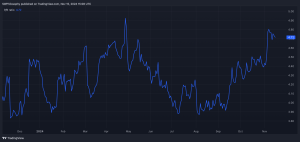Very few shares in the FTSE 100 generate an annual dividend yield of over 9%. The average yearly payout of the leading index is currently just 3.6%.
And even fewer of those look undervalued by more than 50% against their peers by my reckoning.
Add in a further condition of projected annual earnings growth of over 25%, and the list becomes very short indeed.
One firm on it is global investment manager M&G (LSE: MNG).
Share valuation
On the key price-to-book (P/B) stock valuation measurement, M&G currently trades at just 1.3. This is bottom of its competitor group, which has a P/B average of 3.7.
The same applies to M&G’s relative standing on the price-to-sales (P/S) measure of share value. It presently trades at 0.8 compared to a peer group average of 4.4.
So it is a serious bargain on these measures. To find out exactly how much in cash terms, I ran a discounted cash flow analysis.
Using other analysts’ figures and my own, this shows the shares to be 51% undervalued at their present £2.07 price.
So a fair value for the stock would be £4.22, although it may go lower or higher than that.
Dividend yield
In 2023, M&G paid a total dividend of 19.7p a share, giving a current yield of 9.5%.
Therefore, £9,000 – the amount I started investing with 30 years ago – would make £855 in dividends in the first year. Over 10 years on the same average yield this would rise to £8,550, and over 30 years to £25,650.
However, if the dividends were used to buy more M&G shares (‘dividend compounding’), much more could be made.
Specifically, on an average 9.5% yield, an extra £14,185 would be generated after 10 years, not £8,550. And after 30 years on the same basis, an additional £144,854 in dividends would be generated, rather than £25,650.
At that point, the total investment (including the initial £9,000) would pay £14,616 each year in dividend income!
Growth prospects
H1 2024 results saw a 4% fall in adjusted operating profit year on year, to £375m from £390m. This was attributed by the firm to difficult market conditions over the half.
More positively from my perspective is that it made progress on its key ‘Transformation’ programme. This aims to increase its financial strength, simplify the business, and unlock growth.
First, H1 saw it boost its Shareholder Solvency II coverage ratio by 7%, to 210%. Second, it reduced managed costs by 4%. Third, it is combining its Life and Wealth operations to accelerate its growth in the UK retail market. It also plans to imminently launch a new investment fund in the Middle East.
A risk here is that this Transformation programme stalls for some reason. Another is high competition in the sector squeezing its profit margins.
However, consensus analysts’ estimates are that its earnings will grow by 25.7% a year to end-2026. Projections are also that its dividend yield will rise to 10.1% by then.
Will I buy the shares?
I already hold M&G shares for their high yield, extreme undervaluation and excellent growth prospects. As these factors are all still in play, I will buy more very soon.
This post was originally published on Motley Fool







